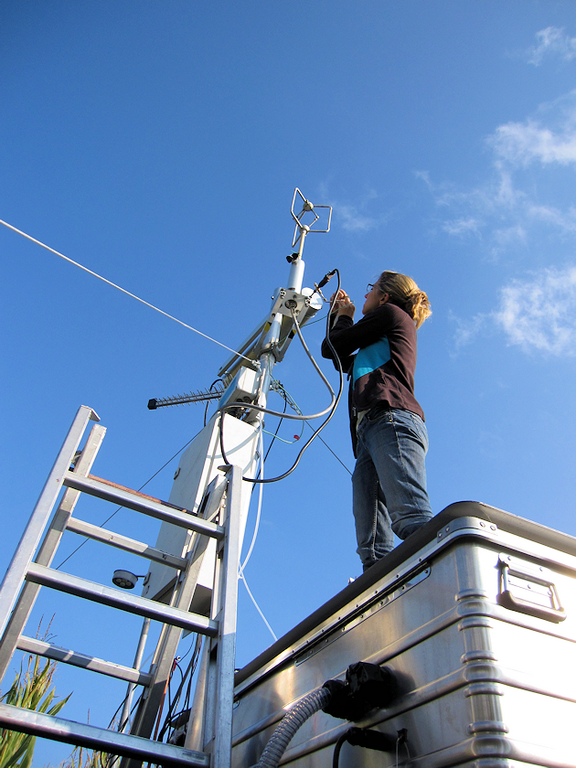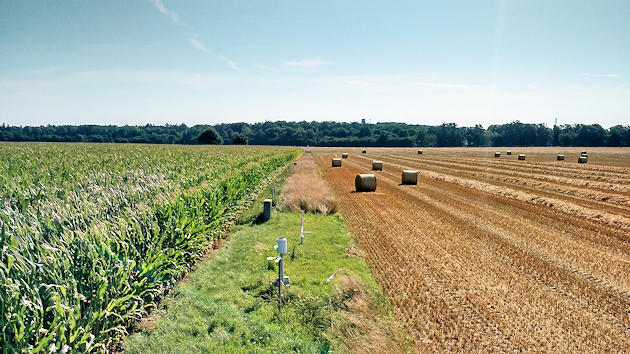Project
NITROSPHERE

A novel approach to investigate effects of atmospheric nitrogen deposition on ecosystem productivity and greenhouse gas exchange
The project NITROSPHERE investigates the relationship between atmospheric nitrogen deposition and greenhouse gas exchange of different ecosystems using novel measurement techniques (TRANC).
Background and Objective
Despite comprehensive investigations in the field of C and N cycling, there is still little knowledge about direct implications of alterations in N deposition on ecosystem productivity and GHG exchange, which can at least partly be attributed to the lack of comprehensive reactive N measurements with high temporal resolution. Thus, the junior research group NITROSPHERE will contribute to ecosystem-atmosphere research by
- establishing an improved methodology (the TRANC) for continuous monitoring of Nr exchange and by
- synthesizing already existing datasets with a special emphasis on the impact of Nr exchange/deposition on gross ecosystem productivity and on other GHG fluxes of affected ecosystems.
Outcomes of the project are also expected to (i) further develop research infrastructures such as ICOS through instrumental and analytical improvements, (ii) increase the potential of global data assimilation networks such as FLUXNET, (iii) providing a better data basis for (re-)formulating Nr emission factors and climate protection regulations, and (iv) enhance the understanding of C and N cycling in both natural and managed ecosystems.
Approach
The group NITROSPHERE will consist of 3 researchers, i.e. two PhD students beside the group leader, and a technician to support all field- and lab-related work. The two PhD students will be assigned to one working package (WP) each and will mainly be responsible for the subtasks and milestones within the respective WP. The focus of WP I lies on Nr measurements and methodology improvement of the recently developed TRANC system. Measurements at peatland, agricultural, and forest sites are planned. WP II deals with data synthesis and Nr modeling to elaborate the relationship between Nr and GHG exchange. All subtasks of the project are expected to be finalized within the first 4 years; a fifth year is intended for further result application such as a regionalization of the obtained relationships.
Results
Our results show that with the newly developed measurement technology the absorption capacity of peatland ecosystems for atmospheric nitrogen can be considerably lower than previously assumed (approx. 35% lower than with conventional methods). For the first time, TRANC and NH3-QCL could were coupled and measured simultaneously as part of NITROSPHERE. QCL and a further developed thermal converter showed good agreement in the measured NH3 concentrations during a comparison campaign. Emission factors of 3.6% could be measured a few days after fertilization on a corn field. This value is well below the 8.2% given by the European Environment Agency (2016). Global radiation and atmospheric concentration play an important role in explaining N-fluxes. For example, 41% of the variability in the exchange behavior of reactive nitrogen could be explained by both drivers. An analysis of the high-frequency losses of ΣNr and NH3 showed that established methods, which are optimized for CO2 and H2O, do not appear to be suitable for reactive gases and, according to the current state of the art, empirical methods should be used to estimate the attenuation.
In the area of modeling, significant progress has been made at various levels of the NH3 exchange determination: In Schrader & Brümmer (2013, 2014), a current review of the literature on NH3 deposition rates was presented. The core results confirm the basic assumption that deposition is particularly high in ecosystems with a high receptor surface (e.g. coniferous forests), whereas there is a high variability in the deposition rate, especially in actively managed ecosystems (e.g. arable land). On the one hand, these updated figures can be used directly for plausibility control and for the conservative estimation of NH3 dry deposition. On the other hand, they also underline the need for local and process-based modeling and the inadequate resolution of constant factors for scientific applications. Schrader et al. (2016) show gaps in knowledge and physically implausible processes in the modeling of the non-stomatal NH3 exchange that are currently being actively worked on. Schrader et al. (submitted) discuss and demonstrate a procedure for the more physiologically correct calculation of the stomatal exchange of NH3 based on the photosynthetic activity of the vegetation. This approach allows mechanistically correct, location-based parameterization of NH3 exchange models and is an important step in the modular structure of NH3 deposition monitoring on existing infrastructures. It also opens up the possibility of a better estimate of the NH3 deposition under future climatic conditions. With the help of the correction method by Schrader et al. (2018) it is possible to calculate valid NH3 deposition rates even with slow-response, low-cost sensors. In the past, significant systematic errors were often ignored and never quantified precisely and rigorously reproduced.

Thünen-Contact

Involved external Thünen-Partners
-
Agroscope
(Reckenholz, Schweiz) - Institut national de recherche pour l’agriculture, l’alimentation et l’environnement (INRAE)
(Paris, Toulouse, Montpellier, Avignon, Ivry-sur-Seine, Clermont-Ferrand, Rennes, Thiverval-Grignon, Dijon, Orleans, Bordeaux, Pierroton, Frankreich)
Funding Body
-
Federal Ministry of Research, Technology and Space (BMFTR)
(national, öffentlich)
Duration
8.2013 - 7.2019
More Information
Project funding number: 01LN1308A
Project status:
finished
Publications
- 0
Wintjen P, Schrader F, Schaap M, Beudert B, Brümmer C (2022) Forest-atmosphere exchange of reactive nitrogen in a remote region - Part I: Measuring temporal dynamics. Biogeosciences 19(2):389-413, DOI:10.5194/bg-19-389-2022
- 1
Wintjen P, Schrader F, Schaap M, Beudert B, Kranenburg R, Brümmer C (2022) Forest-atmosphere exchange of reactive nitrogen in a remote region - Part II: Modeling annual budgets. Biogeosciences 19(22):5287–5311, DOI:10.5194/bg-19-5287-2022
- 2
Lucas-Moffat AM, Schrader F, Herbst M, Brümmer C (2022) Multiple gap-filling for eddy covariance datasets. Agric Forest Meteorol 325(Okt. 2022):109114, DOI:10.1016/j.agrformet.2022.109114
- 3
Brümmer C, Rüffer J, Delorme J-P, Wintjen P, Schrader F, Beudert B, Schaap M, Ammann C (2022) Reactive nitrogen fluxes over peatland and forest ecosystems using micrometeorological measurement techniques. Earth Syst Sci Data 14(2):743-761, DOI:10.5194/essd-14-743-2022
- 4
Brümmer C, Rüffer J, Delorme J-P, Wintjen P, Schrader F, Beudert B, Schaap M, Ammann C (2021) Reactive nitrogen fluxes over peatland (Bourtanger Moor) and forest (Bavarian Forest National Park) using micrometeorological measurement techniques, [Data set, Version 1.0] [Datenpublikation] [online]. 13 Dateien. Genève: Zenodo, zu finden in <https://zenodo.org/record/5841074#.YekbfOcxk2w> [zitiert am 20.01.2022], DOI:10.5281/zenodo.5841074
- 5
Wintjen P, Ammann C, Schrader F, Brümmer C (2020) Correcting high-frequency losses of reactive nitrogen flux measurements. Atmos Measurem Techniques 13(6):2923-2948, DOI:10.5194/amt-13-2923-2020
- 6
Zöll U, Lucas-Moffat AM, Wintjen P, Schrader F, Beudert B, Brümmer C (2019) Is the biosphere-atmosphere exchange of total reactive nitrogen above forest driven by the same factors as carbon dioxide? An analysis using artificial neural networks. Atmos Environ 206:108-118, DOI:10.1016/j.atmosenv.2019.02.042
- 7
Schrader F, Schaap M, Zöll U, Kranenburg R, Brümmer C (2018) The hidden cost of using low-resolution concentration data in the estimation of NH3 dry deposition fluxes. Sci Rep 8:969, DOI:10.1038/s41598-017-18021-6
- 8
Lucas-Moffat AM, Huth V, Augustin J, Brümmer C, Herbst M, Kutsch WL (2018) Towards pairing plot and field scale measurements in managed ecosystems: Using eddy covariance to cross-validate CO2 fluxes modeled from manual chamber campaigns. Agric Forest Meteorol 256-257:362-378, DOI:10.1016/j.agrformet.2018.01.023
- 9
Brümmer C, Lyshede B, Lempio D, Delorme J-P, Rüffer J, Fuß R, Moffat AM, Hurkuck M, Ibrom A, Ambus P, Flessa H, Kutsch WL (2017) Gas chromatography vs. quantum cascade laser-based N2O flux measurements using a novel chamber design. Biogeosciences 14(6):1365-1381, DOI:10.5194/bg-14-1365-2017
- 10
Moffat AM, Brümmer C (2017) Improved parameterization of the commonly used exponential equation for calculating soil-atmosphere exchange fluxes from closed-chamber measurements. Agric Forest Meteorol 240:18-25, DOI:10.1016/j.agrformet.2017.03.005
- 11
Hurkuck M, Brümmer C, Kutsch WL (2016) Near-neutral carbon dioxide balance at a seminatural, temperate bog ecosystem. JGR Biogeosci 12(2):370-384, DOI:10.1002/2015JG003195
- 12
Schrader F, Brümmer C, Flechard CR, Wichink Kruit RJ, Zanten MC van, Zöll U, Hensen A, Erisman JW (2016) Non-stomatal exchange in ammonia dry deposition models: comparison of two state-of-the-art approaches. Atmospheric Chem Phys 16(21):13417-13430, DOI:10.5194/acp-16-11283-2016
- 13
Zöll U, Brümmer C, Schrader F, Ammann C, Ibrom A, Flechard CR, Nelson DD, Zahniser M, Kutsch WL (2016) Surface-atmosphere exchange of ammonia over peatland using QCL-based eddy-covariance measurements and inferential modeling. Atmospheric Chem Phys 16(17):11283-11299, DOI:10.5194/acp-16-11283-2016
- 14
Mohr K, Suda J, Kros H, Brümmer C, Kutsch WL, Hurkuck M, Woesner E, Wesseling W (2015) Atmosphärische Stickstoffeinträge in Hochmoore Nordwestdeutschlands und Möglichkeiten ihrer Reduzierung - eine Fallstudie aus einer landwirtschaftlich intensiv genutzten Region. Braunschweig: Johann Heinrich von Thünen-Institut, 108 p, Thünen Rep 23, DOI:10.3220/REP_23_2015
- 15
Hurkuck M, Brümmer C, Mohr K, Spott O, Well R, Flessa H, Kutsch WL (2015) Effects of grass species and grass growth on atmospheric nitrogen deposition to a bog ecosystem surrounded by intensive agricultural land use. Ecol Evol 5(13):2556-2571, DOI:10.1002/ece3.1534
- 16
Hurkuck M, Brümmer C, Mohr K, Grünhage L, Flessa H, Kutsch WL (2014) Determination of atmospheric nitrogen deposition to a semi-natural peat bog site in an intensively managed agricultural landscape. Atmos Environ 97:296-309, DOI:10.1016/j.atmosenv.2014.08.034
- 17
Schrader F, Brümmer C (2014) Genfer Luftreinhaltekonvention der UNECE: Literaturstudie zu Messungen der Ammoniak-Depositionsgeschwindigkeit. Dessau: Umweltbundesamt, 37 p, Texte UBA 67
- 18
Schrader F, Brümmer C (2014) Land use specific ammonia deposition velocities: a review of recent studies (2004-2013). Water Air Soil Pollut 225:2114, DOI:10.1007/s11270-014-2114-7
- 19
Brümmer C, Marx O, Kutsch WL, Ammann C, Wolff V, Flechard CR, Freibauer A (2013) Fluxes of total reactive atmospheric nitrogen (SNr) using eddy covariance above arable land. Tellus Ser B 65:19770, http://dx.doi.org/10.3402/tellusb.v65i0.19770

![[Translate to English:] [Translate to English:]](/media/_processed_/6/4/csm_titel_CO2Kampagne8_afeea2273e.png)
![[Translate to English:] [Translate to English:]](/media/_processed_/4/1/csm_titel_93px_CO2Kampagne8_9b0f3354d4.png)






